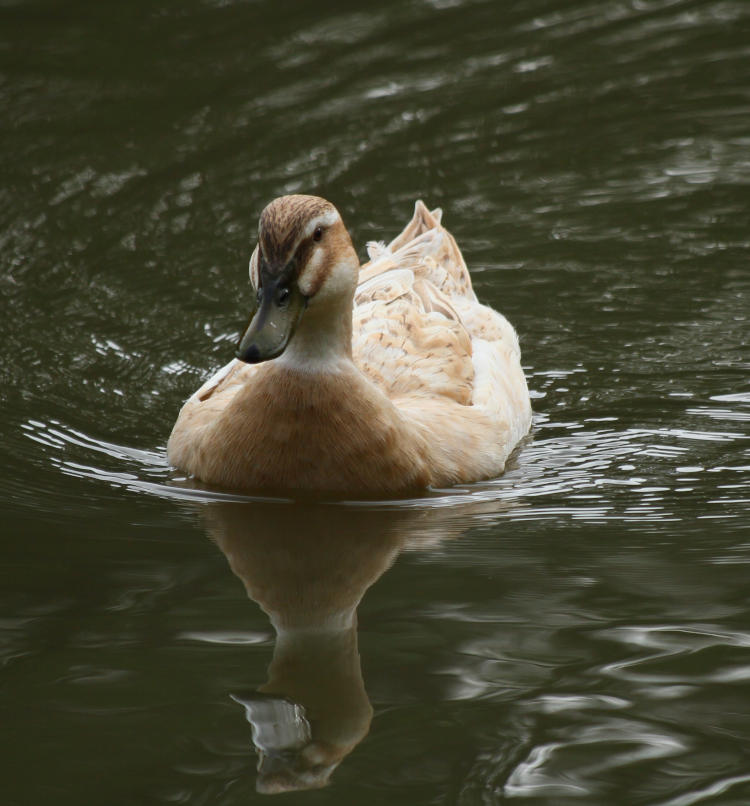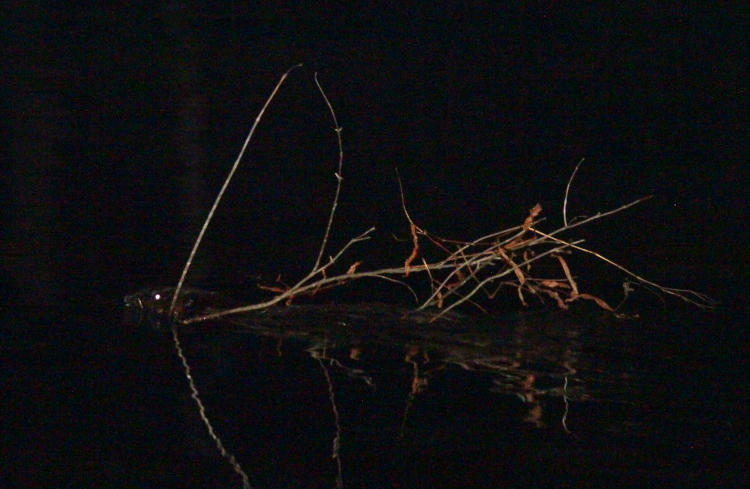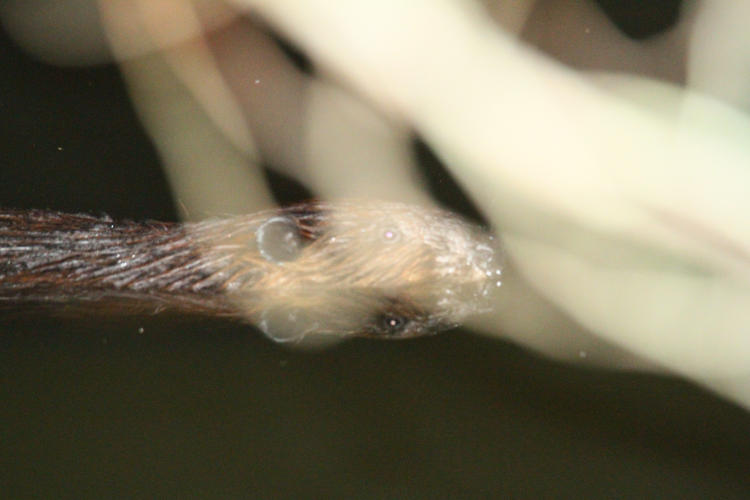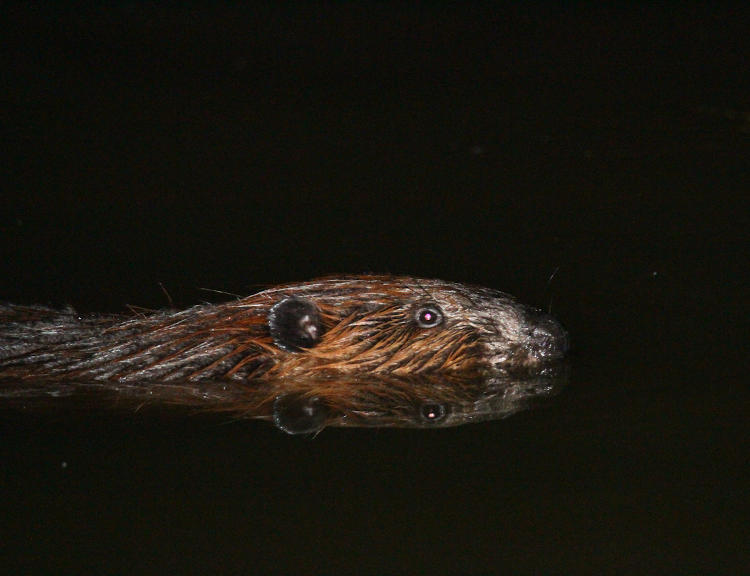Did a quick pass around the nearby pond today, more to get out while the weather was actually pleasant than to chase photo subjects because the light was far from ideal, but I wasn’t so pathetic that I failed to take the camera. So when the little buff female mallard (Anas platyrhynchos) cruised by, I snagged a few frames, including a lovely portrait.

Of all the various summer residents that the pond has had, I’m kind of glad this one chose to stick around, because I like her coloration.
There was also a great blue heron (Ardea herodias) that could be found, like usual, but spooky enough not to allow too close of an approach.

Earlier, The Girlfriend and I had spotted it sitting low in the water like a duck, which I’ve never seen before. I never thought they swam at all, and certainly don’t have the legs or feet for it, but I’ve also never seen them wading that deep, so I can’t say either way. It wasn’t far enough out into the water to preclude a deep wading session, but I’ve never determined actual depth in most areas of the pond either. By the time we got closer (losing sight among trees as we did so,) it had gotten back to typical shoreline behavior as seen above. I had only taken the Canon 100-300 L along this time, for a light kit, and it didn’t quite peg focus too tightly, so this is what we have.
Meanwhile, the evidence of the beaver activity continues to grow.

A couple weeks back i had determined there were at least two North American beavers (Castor canadensis) by spotting one and hearing the warning slap of another while checking out the pond at about 1 AM. And then the overnight temperatures became too cold to merit staking out locations, especially with my sinuses. Last night it had actually been warm enough, but I never thought to check and immersed myself in the previous post and podcast anyway; by the time I realized how warm it was, it was far too late to begin a session.
But this afternoon, what I did find was where the lodge was. Probably.

I’ve never found one of the mid-pond lodges like most people imagine, instead noticing (in this immediate region anyway) that beavers have always made their lodges alongside tree roots in the banks of ponds or streams. My friend, one of the residents around the pond, suspected that the beavers were using the little island, and finding this just about confirmed it. Those are all beaver-cut logs and branches, and were certainly not there a couple of weeks ago, nor are they underneath any noticeable cut trees; I suspect that the entrance is just at the base of the larger roots towards the right.
Given that the temperature tonight was holding at a lovely 18°c, I decided to give it a shot, and this time The Girlfriend came along, hoping to catch a glimpse. I had coached her a little on using the reflections of the residents’ lights on the water to watch for ripples, to point towards a silent beaver cruising past while keeping the headlamps off, and so we sat down in a likely location and waited. There were a few false alarms, and twice the rain started very halfheartedly and gave up, about like my efforts to learn touch-typing. Then The Girlfriend directed my attention to some tiny, sporadic reflections on the opposite shore, ones that really shouldn’t have been there, and we became pretty sure the beavers were up on the bank there. I fired off a few test shots at extreme range, a measured 80 meters from our location (Google Earth is handy,) and got what was likely some eye reflections. Then we started circling the pond to get closer.
We were still about 20 meters from where we’d seen the reflections when the faint shadows of ripples crossing the reflection of the sky could be seen, and I used that for focusing and fired off a couple of frames, with the Vivitar 285HV flash at full power, the Tamron 150-600 at 400mm, and ISO set for 6400 – not ideal, but I was trying to make the most out of the light output. It worked well enough.

That’s the head to the left, with the ruby reflection from one eye, and the body stretches just past mid-frame; obviously we caught someone taking food back to the lodge. Beavers use the larger limbs for building and damming material, often stripping off the tasty bark, and the smaller branches serve as food. Later on, as the new saplings appear and the pond plants start sprouting, they’ll switch to those because they’re more palatable, but beavers are strictly herbivorous; anyone that says they should be removed because of damage to the fish populations is talking out of their ass.
We kept advancing towards where The Girlfriend had spotted the reflections, going slowly because we didn’t know how many there might have been, but afraid that we’d already spooked away the only one. The spot was empty, though we found the newly-cut limb right alongside some wet spots on the trunk, so we knew right where it had been. But then, just before giving up to head home, we saw the ripples again, and they were close.
The bulk of the flash unit atop the camera makes it really hard to use a headlamp as an aiming and focusing guide at night, and I eventually tore it off and handed it to The Girlfriend so she could do the spotlighting, but it was more than enough to peg focus and framing. What it didn’t reveal, however, were the numerous small twigs that sat between me and the beaver, not illuminated by the headlamp. The flash got them, though.

I chimped at the frame, cursed, and shifted position before the beaver decided to dive. Full credit to this one, and to the species in general: out in open water, they often don’t feel threatened and will let their curiosity get the better of them. This one actually turned around after passing and paused, fully illuminated by the strong beam of the headlamp, and I fired off another frame, this time free of those damn twigs.

Granted, this was only 8-10 meters distant now, and the flash can cover that distance. I’d love not to have to use ISO 6400, but we may just have to see what happens later on.
This is not quite full-frame, by the way, cropped only horizontally – the original was a little wider than this. But right now, I’m good with it – it’s probably the best detail that I’ve gotten out of any beaver pics. So far, anyway – I’m aiming for better, especially if I can get one on shore, and an ‘action’ shot would be ideal. They are, occasionally, still out at first light, so perhaps I’ll try again some morning. The temperature is forecast to plummet again, but I don’t think these two (?) are going anywhere soon, and some young may be popping up come spring. We’ll just have to see what happens.




















































